Constitution class
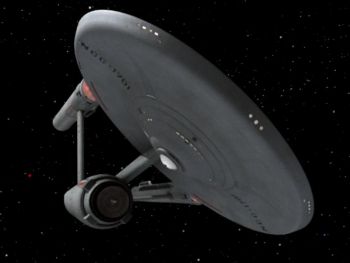
| Mk I | Mk II | Mk III | |
|---|---|---|---|
| Date Entered Service | 2245[3] | Jun 2260 | Feb 2270 |
| Number Constructed | 13 | 28 | 6 |
| Length | 290m | 290m | 295m |
| Width | 127m | 127m | 127m |
| Height | 73m | 73m | 73m |
| Decks | 23[4][5] | 23[4][5] | 23[4][5] |
| Mass | 162,425mt | 164,600mt | 167,900mt |
| Cargo Capacity | 19,000mt | 19,500mt | 19,500mt |
| Computer Type | M-3 | M-4 | M-4 |
| Transporters (Personnel) | 4 | 4 | 4 |
| Transporters (Emergency) | 5 | 5 | 5 |
| Transporters (Cargo) | 2 | 2 | 2 |
| Crew | 203[6] | 430 | 435[3] |
| Passengers | 80 | 60 | 235[3] |
| Evacuation limit | Unk. | Unk. | 3,500[3] |
| Shuttlecraft | 10 | 12 | 12 |
| Cruising Speed | Warp 6 (OCU) | Warp 6 (OCU) | Warp 6 (OCU) |
| Emergency Speed | Warp 8 (OCU) for 12 hours | Warp 8 (OCU) for 12 hours | Warp 8 (OCU) for 12 hours |
| Weapons | 6 FL-6 Phase cannons in 3 banks | 6 FH-3[2] Type IV Phasers[7] in 3 banks | 6 FH-3 Type IV Phasers in 3 banks |
| 2 torpedo tubes;[2] 100 Photon torpedoes[3] | 2 torpedo tubes; 100 Photon torpedoes | 2 torpedo tubes; 100 Photon torpedoes |
The Constitution class[8] cruiser first entered service in 2245.[3] The most renowned vessels of their time, Constitution class cruisers performed their duties to perfection for several decades. An integral part of Starfleet's buildup during "The Great Awakening,"[2] the class also distinguished itself during the Four Years War.[9]
Background
Originally, the class was intended to be much smaller, similar to the Daedalus and Ranger classes that came before it, but a shift in design philosophies and the result of decades of research showed that a larger design could be feasible.[10] The original construction contract called for thirteen vessels to be built, which would serve as cruisers with complete research facilities, capable of operating on five-year research and exploration missions. The prototype U.S.S. Constitution NCC-1700, commissioned in January[2] 2245,[3] was followed by a new ship each month thereafter; the U.S.S. Enterprise NCC-1701 in February, the U.S.S. Constellation NCC-1017 in March, the U.S.S. Intrepid NCC-1631 in April, the U.S.S. Republic NCC-1371 in May, and the U.S.S. Farragut NCC-1647 in June. These first five vessels spent the next two years undergoing shakedown trials,[2] while the remaining seven vessels of the initial authorization of Stardate 0965[11] were built and commissioned over the next five years, ending with the U.S.S. Defiant NCC-1764 in November[2] 2250.
When the Four Years War broke out in 2252,[9] four Constitution class vessels saw combat; each distinguished itself in battle on multiple occasions, garnering the nickname "The Queens of Starfleet" for the class. After-action reports continued to show the class to be superior to any other in the fleet, and in November 2254, Starfleet Command ordered the production of more vessels of the class,[2] and funding for the expansion of the class was authorized by the Starfleet Appropriation of Stardate 3220.[11]
Initial Design
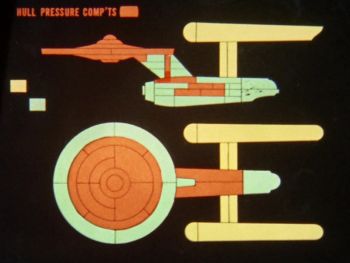
A multirole deep-space exploration cruiser, the Constitution class was able to project a Federation presence further than ever before. The class included a number of enhancements not found on other classes of the era. Lavish accommodations allowed for the performance of diplomatic and courier missions, while an abundance of scientific laboratories and personnel made the class a superb exploratory and scientific platform. A more modular design allowed the rapid replacement of components and the varying of payloads at a moment's notice, as well as easy upgrades during a vessel's operational lifetime, as opposed to lengthy overhauls that kept other classes in spacedock.[10]
While the class originally mounted the Tesla-class[3] FL-6[2] Phase cannons,[13] known colloquially as "Lasers,"[6] the Mark II specifications would introduce FH-3 Phaser emplacements,[2] which were later reclassified as Type IV Phasers.[7] Constitution class starships used Duotronic computers, based on designs developed by Dr. Richard Daystrom in 2243,[14] and mounted the most powerful engines available,[3] based on the revolutionary designs of Dr. Lawrence Marvick.[15] The class also mounted two Mark 12 indirect-fire torpedo tubes[10] and Type I Photon torpedoes,[7] which provided a sizable tactical advantage over older Spatial[10] and Photonic torpedoes.[16] These torpedo launchers were also capable of firing long-range probes, enhancing the Constitution class's sensor and exploration capabilities.[10] The Mark II design also introduced newer, more powerful Shields,[2] and crew capacity was expanded from 203 to 435, following the invention of the improved food synthesizer.[3]
Because of these modifications to the original design, construction didn't begin until September 2255,[2] and the first ship, the U.S.S. Bonhomme Richard NCC-1712,[11] wasn't commissioned until January 2257, seven months after the end of the war. Starfleet decided to continue the production of the Constitution class, and expanded the total number to 42 vessels.[2]
In March 2259, the FWF-1 warp drive was brought into the inventory; all Constitution class ships were recalled to be refit as Mark IIIs,[2] and construction on additional ships was authorized by the Starfleet Authorization of Stardate 5930.[11] By October 2264, the refitting was complete, and the Constitution class remained the most advanced starship of its time.[2] In 2266, only twelve of the original thirteen ships were still in existence.[17]
Emergency separation
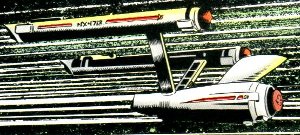
Under extreme circumstances, it was possible to separate the primary hull from the dorsal connector and engineering hull, and to operate both sections independently.[19][20] If performed as part of an abandon ship situation, the crippled portion of the ship would be evacuated into the other section, and the two sections would be separated by activation of explosive bolts at the joint. The primary hull would then be controlled by the Main Bridge, while the engineering hull would be controlled by the Auxiliary Bridge on Deck 19, aft of the main deflector array. Following separation, the primary hull could operate at up to .96c on the main impulse engines, located at the aft end of the saucer. The separated engineering hull, using the warp drive, could maneuver at up to .98c,[20] as well as at warp speeds.[18] Once separated, the two sections could not be reattached autonomously, and required the use of a major shipyard facility or specially equipped work crews from such a facility.[20]
Internal configuration
Command Systems
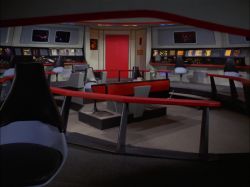
The central command area for the ship, the Main Bridge was located on Deck 1,[6] and had sensor equipment mounted under a dome atop the bridge module, which supplemented readings received from the main dish.[20] An Emergency Bridge was also located at the heart of Deck 7, deep within the primary hull, where it was surrounded by the ship's medical facilities and computer core.[4] This facility could be used if the Main Bridge was disabled due to damage or malfunction.[20] On Deck 19 in the secondary hull was a third bridge module, located adjacent to a secondary computer core directly aft of the ship's deflector array.[4] This bridge module was intended for use in the event of saucer separation, at which point the engineering hull would operate independently of the saucer.[20]
The captain's office was located on Deck 7.[4] The office had a private bathroom and a reception area outside of the office. The office was used when the captain was not on the bridge or in his quarters, and was primarily used for formal individual or small meetings.[20] The captain also had a private observation lounge, located on Deck 12, within the dorsal "neck." Senior officers had individual offices away from the bridge, which were scattered throughout the ship, adjacent to their respective departments' facilities: the executive officer's office was located on Deck 8; the science officer's office was located on Deck 2, with the science labs; the chief medical officer's office was located within the sickbay facility on Deck 7; and the chief navigator's office was located near the chart room on Deck 7,[4] which held navigational data in both electronic and hard copies.[20]
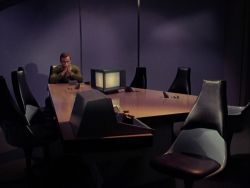
Conference and briefing rooms were likewise scattered throughout the ship, on Decks 4, 5, 7, and 19.[4] The Deck 4 conference room was used primarily by junior officers, passengers, and bridge personnel. The Deck 5 briefing room was often used for crew instruction, meetings, and small hearings. Classes were often held here as refreshers, to impart new information, and for anyone interested in broadening their horizons; courses ranged from formal instruction to informal courses on Three-dimensional chess, literature, and music. The briefing room on Deck 7 was used primarily by bridge personnel and the medical department, as well as a staging area for personnel about to embark via the transporters, also located on that deck, and as a debriefing area for landing parties. The Deck 19 briefing room was primarily used by personnel using the ship's auxiliary craft, given its proximity to the shuttlebay.[20]
Sciences
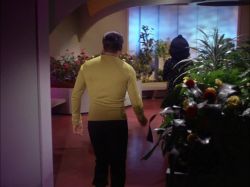
The Constitution class had fourteen separate science labs.[23] A number of these labs were located on Decks 2 and 3. These labs were dedicated to chemistry, energy, biology, geology, physics, cosmology, and botany. Deck 18 held the ship's hydroponics laboratory,[4] where fresh fruits and vegetables, along with other plants, could be grown. While it wasn't possible for the hydroponics lab to grow enough food to feed the entire crew, enough could be grown for special occasions,[20] such as flowers for decoration.[15] Also on Deck 18 was a botany lab, with a high bay that extended up into Deck 17. The Science Officer's office was located on Deck 2, adjacent to the laboratories.[4]
Medical
The majority of the Constitution class medical facilities were located at the heart of Deck 7, with the main Sickbay, medical labs, operating/examination rooms, convalescent ward, thereaputic baths, obstetrics, dental unit, and medical supplies storage all arranged in a ring surrounding the ship's Emergency Bridge and computer core, a location that offered the greatest protection to these sensitive areas. Additional medical facilities were located on Deck 16 of the secondary hull,[4] for use in case of emergencies in the engineering sections of that hull, or in case of emergency saucer separation. The primary medical facility was normally staffed by the Chief Medical Officer (CMO), while the secondary facility was staffed by the Assistant CMO.[20]
Security/Tactical
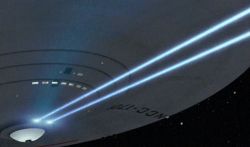
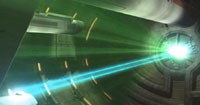
Two forward-facing torpedo tubes were mounted on Deck 3, and the ship's phaser banks were mounted on Decks 5 and 11, with the Auxiliary Fire Control room adjoining the forward phaser bank on Deck 11.[4] From Auxiliary Fire Control, the ship's weapons could be fired manually,[26] in case the remote firing equipment on the Bridge was damaged or disabled.[20] An aft-facing phaser array was located on Deck 15, above the Shuttle Control Room directly above the Shuttlebay doors at the aft of the ship,[25] co-located with sensor equipment beneath a semi-transparent dome.[4]
Security facilities were located on Deck 7 of the primary hull, near the ship's transporter rooms. Adjacent to the security office was a small arms arsenal,[4] which was normally locked and guarded, either directly by security personnel or via security monitor.[20] Also on Deck 7 was the ship's Brig,[4] which consisted of ten cells, all with forcefield protective doors.[20] A secondary security section, with its own brig and small arms arsenal, was located in the secondary hull on Deck 19.[4]
Engineering
The ship's impulse engines were located on Decks 6 and 7, at the aft end of the primary hull, and the engineering section that controlled these engines was located immediately adjacent to them on those decks. Main Engineering was located on Deck 16,[4] with controls for the ship's warp drive located at this facility,[20] with access to Jefferies tubes to the engines to the aft.[4] Also on Deck 6 was a turbolift maintenance shop,[4] which contained equipment for repair and maintenance of the ship's turbolift system, as well as controls for manual override of the system, allowing turbolift cars to be recalled or sent to any location on a priority basis, overriding local lift control,[20] with a secondary turbolift maintenance shop on Deck 16. Emergency batteries were located on Decks 4 and 20.[4]
Life support, fabrication, and wastes recovery/reclamation systems were also located in multiple locations throughout the ship, with redundant systems in the primary and secondary hulls on Decks 4, 8, 9, 15, 21, and 22. Fresh water storage was located on Deck 8 in the primary hull, and Deck 15 in the secondary hull. Cargo holds and raw materials storage were located on Decks 9 and 10 in the primary hull, and on Decks 20 through 23 in the secondary hull; in both cases, these storage areas were adjacent to cargo transporter systems and the shuttlebay. The ship's main computer core was located on Decks 7 and 8, buried deep within the primary hull, with secondary core on Decks 16 and 17 in the secondary hull.[4]
Transporters
Four personnel transporters were located on Deck 7. Three emergency transporters, capable of transporting 22 people at a time, were located on Deck 8, with another two on Deck 22 in the secondary hull. One cargo transporter was located on Deck 10, adjacent to the cargo holds in the primary hull, with a second on Deck 23.
Accommodations
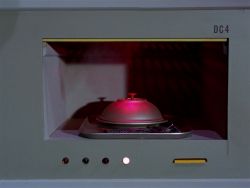
Single-occupancy quarters for senior officers and VIP staterooms were located on Deck 5. Double-occupancy quarters for junior officers and passengers were located on Decks 4 and 5, and double-occupancy quarters for enlisted personnel and passengers were located on Decks 6 and 7. Additional double-occupancy quarters were located on Decks 17 through 19 in the engineering hull for personnel assigned to medical and engineering in the secondary hull.[4][20] The ship's laundry was located on Deck 8 in the primary hull, and on Deck 21 in the secondary hull.[4] This facility broke down clothing into its original components, extracted foreign matter, then recreated the item in the needed size and shape; the ship's computer stored crew members' sizes, so clothing was always immediately available.[20]
Mess rooms were located at the center core of Deck 6 and on Deck 7 in the primary hull, and on Decks 17, 18, and 22 in the secondary hull.[4] Food was delivered to food slots throughout the ship via a system of small turbolifts from the ship's galley,[20] located on Deck 8; secondary galleys were located in the engineering hull on Decks 21 and 22,[4] which supplemented the primary hull facilities in addition to serving the secondary hull.[20]

Lounges and other recreational facilities were available for use throughout the ship, on Decks 5, 6, and 8 in the primary hull, and on Decks 9, 13, and 14 in the secondary hull's dorsal "neck."[4] The lounge on Deck 5, while intended for senior officers, was open to any crewmember or visitor.[20] Typically, lounges offered food slots, viewscreens for entertainment channels, and games.[29] The Recreation Center, located on Deck 8,[4] used holographic projections and other complicated scenery to generate convincing recreations of planetary landscapes[28] or other settins, and could also be used to play back holographic recordings, enabling a kind of "holographic mail call" for the crew.[20] The ship's gymnasium facilities were located on Deck 8 in the primary hull, and on Deck 20 in the secondary hull.[4] The gymnasium was a large room, complete with equipment, showers, and lockers. In addition to opportunities for individual workouts, classes were also held to help keep personnel in shape.[20] Deck 20 also was home to an 18-meter pool, which extended into Deck 21, as well as a second holographic Recreation Center.[4] The ship's chapel[26] was located on Deck 7,[4] and was used for the crew's various religious services, weddings, and memorial services.[20]
Auxiliary Spacecraft Systems
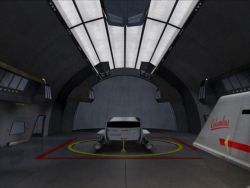
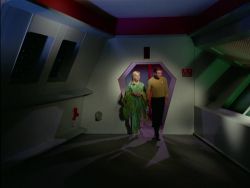
The shuttlebay spanned Decks 16 through 19.[4] On Deck 16, at the aft of the ship, the shuttle control room looked out into space through a large window at the top of the hangar doors.[31] This control room oversaw operation of the bay doors, the shuttle elevator/turntable at the base of the shuttlebay on Deck 19, atmospheric control, and cargo handling in the bay.[20] On Deck 17, observation galleries ran along the sides of the shuttlebay, with windows overlooking the bay as well as looking out into space.[17] The area was often crowded with off-duty personnel when shuttles were in use.[20] The shuttle elevator/turntable located at the center of the shuttlebay could be used to transfer shuttlecraft to the shuttle maintenance area on Deck 20, and the shuttlecraft storage area on Deck 21.[4]
Major Refit
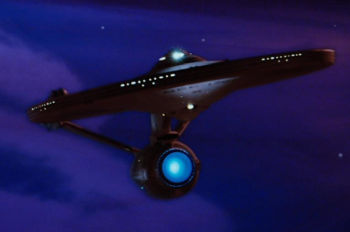
| Mk I | Mk II | Mk III | Mk IV[33] | |
|---|---|---|---|---|
| Date Entered Service | 2273[34] | Oct 2277 | Feb 2279 | Feb 2286 |
| Number Constructed | 26 | 19 | 10 | 50 |
| Length | 302m | 302m | 302m | 322m |
| Width | 131m | 131m | 131m | 131m |
| Height | 74m | 74m | 74m | 78m |
| Decks | 23[7] | 23[7] | 23[7] | 23[7] |
| Mass | 160,275mt | 163,275mt | 171,008mt | 197,543mt |
| Cargo Capacity | 22,500mt | 22,500mt | 22,500mt | 22,500mt |
| Computer Type | M-6 | M-6 | M-6A | M-7A |
| Transporters (Personnel) | 4 | 4 | 4 | 4 |
| Transportes (Emergency) | 4 | 4 | 4 | 4 |
| Transporters (Cargo) | 2 | 2 | 2 | 2 large, 2 small |
| Crew | 412 | 416 | 416 | 422 |
| Passengers | 60 | 60 | 60 | 50 |
| Shuttlecraft | 12 | 12 | 12 | 10 |
| Crusing Speed | Warp 8 (OCU) | Warp 8 (OCU) | Warp 8 (OCU) | Warp 12 (OCU) |
| Emergency Speed | Warp 10 (OCU) | Warp 10 (OCU) | Warp 10 (OCU) | Warp 14 (OCU) |
| Weapons | 6 FH-11 (Type VII[7]) Phasers in 3 banks | 6 FH-11 (Type VII[7]) Phasers in 3 banks | 8 FH-11 (Type VII[7]) Phasers in 4 banks | 8 FH-11 (Type VII[7]) Phasers in 4 banks |
| 2 torpedo tubes | 2 torpedo tubes | 3 torpedo tubes | 4 torpedo tubes |
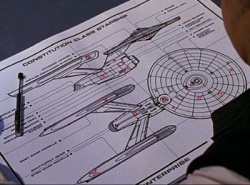
On Stardate 7523.2—7 April[36] 2270[37]—the U.S.S. Enterprise returned to Earth orbit following its last, historic five-year mission,[36] by that point the only one of the original thirteen Constitution class vessels remaining in service.[2] Although the decision had been made three months earlier to decommission and scrap the Enterprise, the ship had come to be seen as a symbol of Starfleet and the Federation. This swell of public opinion drove a motion in the Federation Council that led to a reversal of Starfleet's plans. The Enterprise, however, was still twenty-five years old; her systems were becoming outdated, and it soon became apparent that only a major refit could keep the ship at the forefront of the fleet.[36] What began as a simple refit to the Mark IV specifications[2] quickly evolved into a redesign of the entire vessel.[34]
Engineering
At the suggestion of Commander Montgomery Scott, the Enterprise's chief engineer, the ship was outfitted with the new FWG-1[2] / LN-64 Mod 3[10] warp engines, which would give the ship 33% more operating power and increase its range. This, however, required a new pylon assembly capable of withstanding the forces exerted by the higher speeds,[2] which in turn led to several design changes in the secondary hull.[34] The secondary hull was enlarged, giving room for larger shuttlebays, larger and more efficiently-arranged engineering compartments, enlarged and improved research facilities, and an enclosed deflector array.[2] The primary hull was likewise expanded,[34] to allow room for new control, life support, and computer systems,[2] and sickbay was massively redesigned.[34]
Command Systems
The M-4 computer system installed on the Constitution class prior to 2270 was inadequate to the task of handling the new propulsion and deflector systems,[36] so the new M-6 computer system was installed,[2] requiring further modification to the primary hull.[36] While the M-4 occupied the central areas of Decks 7 and 8,[4][36] the M-6 was housed in a central core shaft eight feet in diameter, which extended from Decks 2 through 11. At the midpoint of Deck 7, surrounding the computer core, was the ship's auxiliary control room, which was also known as the ship's Emergency or Auxiliary Bridge; it could assume all functions of the Main Bridge, should damage or malfunction cause it to become unusable. Designed for use in extreme combat situations, the auxiliary control room was deep within the primary hull, and was the best protected location aboard the ship.[36]
Security/Tactical
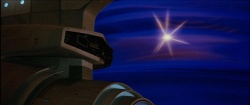
The torpedo launchers were moved from the primary hull to the base of the dorsal connector on the engineering hull,[34] and the newer launchers increased firepower by more than 20%.[10] Though the torpedo launchers were initially intended to be fully automated, shortening the launch time by twenty percent, an unforeseen overheating problem plagued the auto-arming system, aborting seven percent of all attempted launches. Decks 12 and 13 were modified to house a two-level complex of photon torpedo storage and launching machinery. A backup firing computer was installed on Deck 12, just aft of the turbolift shaft.[36] The torpedo launch tubes joined at the aft, allowing a single loading mechanism to service both tubes.[32] Each tube was capable of holding four torpedoes at the ready for rapid firing.[36] The phaser arrays were replaced by the new FH-11[2] / RIM-12C emplacements, which would later be redesignated the Type V.[10] These phasers drew power directly from the warp engines,[34] dramatically increasing their capabilities over the older Type IV.[10]
The auxiliary fire control center was located at the center of Deck 7, surrounding the computer core and directly beneath the auxiliary control room; all shipboard weapon systems could be controlled manually from this location. Also on this deck, adjoining the briefing room, was the ship's armory, as well as the main brig.[36]
Sickbay
The improved sickbay complex formed a half-ring near the aft center of Deck 7. The latest advances in Federation medical technology could be found in the facility. A closed-circuit mini-transporter system, installed at various locations throughout the medical section, allowed tissue samples and cultures to be sent instantaneously to or from any lab aboard the ship.[36]
Accommodations
Deck 2 was converted from science laboratories to a VIP/Officers' lounge,[34] as well as the officers' mess, which dominated the deck. The lounge area also included a bar, outfitted with updated food slots that were installed throughout the ship, and a privacy area.[36]
Crew quarters and recreational facilities were eliminated from the secondary hull, allowing space for the expanded cargo deck, shuttlebay, and engineering facilities. Double-occupancy VIP staterooms were located on Deck 4, as well as a conference room and junior officers' quarters, which were now single-occupancy rooms with individual bathrooms. Deck 5 housed the ship's senior officers' quarters, as well as additional VIP staterooms; senior officers' quarters were nearly identical to the VIP staterooms, except they were single-occupancy rooms. The majority of Deck 6 was occupied by crew quarters, which were single-occupancy rooms, with two rooms sharing a common bathroom. At the center of the deck was the crew mess, and the upper level of the rec deck was located at the aft end of the deck, to starboard of the impulse engines. Adjoining this was the crew lounge, which was similar to the officers' lounge on Deck 2. The main level of the rec deck was located on Deck 7; this room provided off-duty personnel with electronic games and library facilities, while bowling and racquetball facilities adjoined the reck deck on its starboard side. Additionally, the ship's chapel was located on Deck 7.[36]
Auxiliary Spacecraft Systems
Starfleet's standardized docking ports, used by travel pods[34] and the new Type SW-7 Shuttlecraft,[38][34] were also installed on Decks 8, 13, and 17, as well as the aft of the new bridge module.[34][36] Deck 8 was often referred to as the "docking level," as it housed the primary hull's two main docking port complexes,[36] which were normally concealed behind sliding doors that remained flush with the rest of the outer hull when closed.[34] Each docking port contained storage bays with EVA gear and hull repair materials.[34][36]
Constitution class vessels
| Registry | Ship | Commissioned |
|---|---|---|
| 1732 | Achernar | Unk. |
| 1818 | Acrux | Unk. |
| 1827 | Adhara | Unk. |
| 1816 | Agena | Unk. |
| 1790 | Ahzdar | Unk. |
| 1796 | Alam'ak | Unk. |
| 1812 | Aldebaran | Unk. |
| 1781 | Alferaz | Unk. |
| 1741 | Alfr | Unk. |
| 1828 | Alioth | Unk. |
| 1829 | Alkaid | Unk. |
| 1803 | Altair | Unk. |
| 1821 | Anak | Unk. |
| 1738 | Androcus | Unk. |
| 1752 | Annobon | Unk. |
| 1820 | Antares | Unk. |
| 1807 | Arcturus | Unk. |
| 1723 | Ari | Unk. |
| 1831 | Arided | Unk. |
| 1739 | Astrad | Unk. |
| 1797 | Behr'ak | Unk. |
| 1832 | Bellatrix | Unk. |
| 1822 | Betelgeuse | Unk. |
| 1819 | Binar | Unk. |
| 1712 | Bonhomme Richard | 2257-01 |
| 1814 | Canopus | Unk. |
| 1809 | Capella | Unk. |
| 1833 | Castor | Unk. |
| Unk. | Christopher Pike | Unk. |
| Unk. | Confederate | 2269 |
| 1017 | Constellation | 2245-03 |
| 1728 | Constellation | 2275-11 |
| 1700 | Constitution | 2245-01 |
| 1700-A | Constitution | Unk. |
| 1798 | Czar'ak | Unk. |
| 1810 | Darion | Unk. |
| 1764 | Defiant | 2250-11 |
| 1826 | Deneb | Unk. |
| 956 | Eagle | 2262-05 |
| 1771 | Ekinus | Unk. |
| 1722 | El Dorado | 2259-09 |
| 1835 | El Nath | Unk. |
| 1792 | Elohim | Unk. |
| 1895 | Endeavour | 2251 |
| 1701 | Enterprise | 2245-02 |
| 1701 | Enterprise (Alternate) | 2245-02 |
| 1701-A | Enterprise | 2286-12 |
| 1779 | Esabl | Unk. |
| 1789 | Eskiis | Unk. |
| 1697 | Essex | 2259-04 |
| 1664 | Excalibur | 2246-01 |
| 1711 | Excalibur | 2276-08 |
| 1718 | Excelsior | Unk. |
| 1672 | Exeter | 2247-03 |
| 1706 | Exeter | 2276-05 |
| 1966 | Explorer | Unk. |
| 1647 | Farragut | 2245-06 |
| 1729 | Farragut | 2276-02 |
| 1804 | Fomalhaut | Unk. |
| 1786 | Ghar | Unk. |
| 1749 | Ghondr | Unk. |
| 1782 | Hajj | Unk. |
| 1793 | Heimdal | Unk. |
| 1825 | Helios | Unk. |
| 1703 | Potemkin | 2250-07 |
| 1813 | Hor | Unk. |
| 1714 | Hornet | Unk. |
| 1748 | Horok | Unk. |
| 1631 | Intrepid | 2245-04 |
| 1851 | Intrepid | 2269 |
| 1754 | Jassan | Unk. |
| 1791 | Jenshahn | Unk. |
| 1734 | Jupiter | Unk. |
| 1802 | K'Hotan | Unk. |
| 1801 | K'Ushui | Unk. |
| 1769 | Kars | Unk. |
| 1710 | Kongo | 2257-09 |
| 1767 | Kep Salu | Unk. |
| 1766 | Kestral | Unk. |
| 1768 | Ketoi | Unk. |
| 1726 | Krieger | Unk. |
| 1720 | Lafayette | Unk. |
| 1709 | Lexington | 2246-12 |
| 1823 | Lux | Unk. |
| 1794 | Maat | Unk. |
| 1778 | Mazda | Unk. |
| 1773 | Mengen | Unk. |
| 1715 | Merrimac | 2258-08 |
| 1836 | Miaplacidas | Unk. |
| 1788 | Mirazh | Unk. |
| 1740 | Mondoloy | Unk. |
| 1785 | Mongo | Unk. |
| 1713 | Monitor | Unk. |
| 1838 | Murzim | Unk. |
| 1758 | Ndele | Unk. |
| 1772 | Oblik | Unk. |
| 1761 | Oomaru | Unk. |
| 1755 | Paegan | Unk. |
| 1787 | Pari | Unk. |
| 1750 | Peilone | Unk. |
| 1746 | Pilar | Unk. |
| 1839 | Polaris | Unk. |
| 1808 | Pollux | Unk. |
| 1657 | Potemkin | 2249-06 |
| 1702 | Potemkin | 2275-04 |
| 1756 | Procyon | Unk. |
| 1737 | Proxima | Unk. |
| 1736 | Quindar | Unk. |
| 1775 | Qizan | Unk. |
| 1776 | Qual'at | Unk. |
| 1707 | Ranger | Unk. |
| 1840 | Regulus | Unk. |
| 1371 | Republic | 2245-05 |
| 1753 | Republic | 2277-04 |
| 1824 | Rigel | Unk. |
| 1735 | Rigil Kentaurus | Unk. |
| 1774 | Salayna | Unk. |
| 1765 | Samaara | Unk. |
| 1724 | Saratoga | 2259-05 |
| 1811 | Sardar | Unk. |
| 1795 | Shaandra | Unk. |
| 1745 | Shahr | Unk. |
| 1744 | Sirius | Unk. |
| 1733 | Sol | Unk. |
| 1730 | Soryu | Unk. |
| 1815 | Spica | Unk. |
| 1783 | Tajarhi | Unk. |
| 1751 | Tali | Unk. |
| 1763 | Temir | Unk. |
| 1742 | Thelonii | Unk. |
| 1747 | Tholus | Unk. |
| 1725 | Tori | 2260-02 |
| 1777 | Tulan | Unk. |
| 1799 | Tutakai | Unk. |
| 1731 | Valiant | 2258-10 |
| 1806 | Vega | Unk. |
| 1817 | Vena | Unk. |
| 1721 | Wasp | Unk. |
| 1842 | Wezen | Unk. |
| 1743 | Xanthii | Unk. |
| 1762 | Yaan | Unk. |
| 1705 | Yamato | 2257-03 |
| 1704 | Yorktown | 2247-05 |
| 1717 | Yorktown | 2275-12 |
| 1760 | Za'Faran | Unk. |
| 1780 | Zaahm | Unk. |
| 1759 | Zindar | Unk. |
| 1716 | Zuiho | Unk. |
References
- ↑ "Dagger of the Mind." Star Trek, Episode 10. Television. 3 November 1966.
- ↑ 2.00 2.01 2.02 2.03 2.04 2.05 2.06 2.07 2.08 2.09 2.10 2.11 2.12 2.13 2.14 2.15 2.16 2.17 2.18 2.19 2.20 2.21 2.22 2.23 "Federation Ship Recognition Manual." Star Trek: The Roleplaying Game, Supplement 2302. Game. FASA. 1985.
- ↑ 3.0 3.1 3.2 3.3 3.4 3.5 3.6 3.7 3.8 3.9 "Core Game Book." Star Trek Roleplayng Game, Supplement 45000. Game. 1999. Last Unicorn Games, Inc.
- ↑ 4.00 4.01 4.02 4.03 4.04 4.05 4.06 4.07 4.08 4.09 4.10 4.11 4.12 4.13 4.14 4.15 4.16 4.17 4.18 4.19 4.20 4.21 4.22 4.23 4.24 4.25 4.26 4.27 4.28 4.29 4.30 4.31 4.32 "Star Trek Blueprints." Star Trek. Book. 1973. Ballantine Books.
- ↑ 5.0 5.1 5.2 "Player's's Guide." Star Trek Roleplayng Game, Book 1. Game. 2002. Decipher, Inc.
- ↑ 6.0 6.1 6.2 "The Cage." Star Trek, Episode 0. Television. 1965 (Unaired).
- ↑ 7.00 7.01 7.02 7.03 7.04 7.05 7.06 7.07 7.08 7.09 7.10 "Narrator's Guide." Star Trek Roleplayng Game, Book 2. Game. 2002. Decipher, Inc.
- ↑ "The Trouble With Tribbles." Star Trek, Episode 42. Television. 29 December 1967.
- ↑ 9.0 9.1 "The Four Years War." Star Trek: The Roleplaying Game, Supplement 2218A. Game. FASA. 1986.
- ↑ 10.0 10.1 10.2 10.3 10.4 10.5 10.6 10.7 10.8 "Starships." Star Trek Roleplayng Game, Book 4. Game. 2003. Decipher, Inc.
- ↑ 11.0 11.1 11.2 11.3 "Star Fleet Technical Manual." Star Trek. Book. 1975. Ballantine Books.
- ↑ "Day of the Dove." Star Trek, Episode 66. Television. 1 November 1968.
- ↑ "Silent Enemy." Enterprise, Episode 12. Television. 16 January 2002.
- ↑ "The Ultimate Computer." Star Trek, Episode 53. Television. 8 March 1968.
- ↑ 15.0 15.1 15.2 "Is There In Truth No Beauty?." Star Trek, Episode 62. Television. 18 October 1968.
- ↑ "The Expanse." Enterprise, Episode 52. Television. 21 May 2003.
- ↑ 17.0 17.1 17.2 "The Conscience of the King." Star Trek, Episode 12. Television. 8 December 1966.
- ↑ 18.0 18.1 "None But the Brave." Star Trek: Unlimited, Issue 4. Comic Book. May 1997. Marvel Comics.
- ↑ "The Apple." Star Trek, Episode 38. Television. 13 October 1967.
- ↑ 20.00 20.01 20.02 20.03 20.04 20.05 20.06 20.07 20.08 20.09 20.10 20.11 20.12 20.13 20.14 20.15 20.16 20.17 20.18 20.19 20.20 20.21 20.22 20.23 20.24 20.25 "Adventure Book." Star Trek: The Roleplaying Game, Supplement 2001B. Game. FASA. 1983.
- ↑ "The Mark of Gideon." Star Trek, Episode 72. Television. 17 January 1969.
- ↑ "The Enemy Within." Star Trek, Episode 4. Television. 6 October 1966.
- ↑ "Operation: Annihilate!." Star Trek, Episode 29. Television. 13 April 1967.
- ↑ "The Corbomite Maneuver." Star Trek, Episode 2. Television. 10 November 1966.
- ↑ 25.0 25.1 "In a Mirror, Darkly, Part II." Star Trek: Enterprise, Episode 95. Television. 29 April 2005.
- ↑ 26.0 26.1 "Balance of Terror." Star Trek, Episode 8. Television. 15 December 1966.
- ↑ 27.0 27.1 27.2 "The Naked Time." Star Trek, Episode 6. Television. 29 September 1966.
- ↑ 28.0 28.1 "Practical Joker." Star Trek: The Animated Series, Episode 20. Television. 21 September 1974.
- ↑ "Where No Man Has Gone Before." Star Trek, Episode 1. Television. 22 September 1966.
- ↑ "The Galileo Seven." Star Trek, Episode 13. Television. 5 January 1967.
- ↑ "The Doomsday Machine." Star Trek, Episode 35. Television. 20 October 1967.
- ↑ 32.0 32.1 32.2 Star Trek II: The Wrath of Khan. Film. 4 June 1982.
- ↑ "Star Trek: The Next Generation Officer's Manual." Star Trek: The Roleplaying Game, Supplement 2012. Game. FASA. 1988.
- ↑ 34.00 34.01 34.02 34.03 34.04 34.05 34.06 34.07 34.08 34.09 34.10 34.11 34.12 34.13 34.14 34.15 Star Trek: The Motion Picture. Film. 7 December 1979.
- ↑ Star Trek VI: The Undiscovered Country. Film. 6 December 1991.
- ↑ 36.00 36.01 36.02 36.03 36.04 36.05 36.06 36.07 36.08 36.09 36.10 36.11 36.12 36.13 36.14 36.15 "Mr. Scott's Guide to the Enterprise." Book. July 1987. Pocket Books.
- ↑ "Q2." Star Trek: Voyager, Episode 265. Television. 11 April 2001.
- ↑ "Star Trek III: The Search for Spock Sourcebook Update." Star Trek: The Roleplaying Game, Supplement 2214. Game. FASA. 1986.